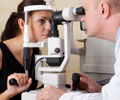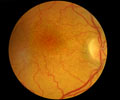
The new portable ophthalmic-screening instrument was invented by researchers at the Massachusetts Institute of Technology in collaboration with the University of Erlangen and Praevium/Thorlabs.
Although other research groups and companies have created hand-held devices using similar technology, the new design is the first to combine cutting-edge technologies such as ultrahigh-speed 3-D imaging, a tiny micro-electro-mechanical systems (MEMS) mirror for scanning, and a technique to correct for unintentional movement by the patient.
The instrument uses a technique called optical coherence tomography (OCT) that sends beams of infrared light into the eye and onto the retina.
Echoes of this light return to the instrument, which uses interferometry to measures changes in the time delay and magnitude of the returning light echoes, revealing the cross sectional tissue structure of the retina-similar to radar or ultrasound imaging.
Tabletop OCT imagers have become a standard of care in ophthalmology, and current generation hand-held scanners are used for imaging infants and monitoring retinal surgery.
Advertisement
They tested two designs, one of which is similar to a handheld video camera with a flat-screen display. In their tests, the researchers found that their device can acquire images comparable in quality to conventional table-top OCT instruments used by ophthalmologists.
Advertisement
By using multiple 3-D images of the same part of the retina, it is possible to correct for distortions due to motion of the operator's hand or the subject's own eye.
The next step, researcher James Fujimoto of MIT said, is to evaluate the technology in a clinical setting.
But the device is still relatively expensive, he added, and before this technology finds its way into doctors' offices or in the field, manufacturers will have to find a way to support or lower its cost.
The study is published in the open-access journal Biomedical Optics Express.
Source-ANI












